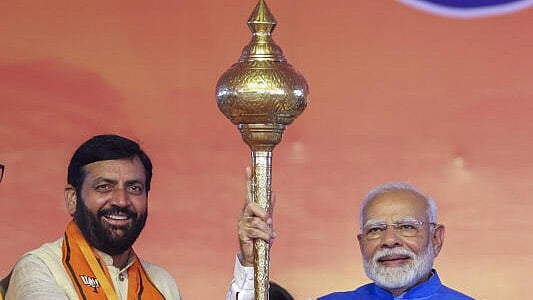
Haryana CM Nayab Singh Saini (left) with PM Narendra Modi
Credit: PTI Photo
It appears at the time of writing that the Congress has suffered a stunning setback in Haryana. This can have longer-term implications for the Opposition, especially with elections impending in two more states later this year. The better-than-expected results for the Indian National Developmental Inclusive Alliance (I.N.D.I.A) in Jammu & Kashmir will be distinctly cold comfort.
The Congress started the day on a high note in Haryana, surging way ahead of the Bharatiya Janata Party (BJP), but the latter shrugged off the predicted anti-incumbency sentiment accumulated over 10 years in power to first creep up on the Opposition and then roar past it in a role reversal that seemed to come from nowhere. The exit polls that had predicted anything between a slim to a comfortable win for the Congress were once again upended.
The ‘poll of polls’ had predicted 55 seats for the Congress in an Assembly with 90 seats, with the BJP’s tally pegged at 27 — this was a comfortable majority. At the lower end, the Congress was given 49 seats and the BJP 24, with Independents and others making up the numbers. Even this would not have been worrisome for the Congress. Instead, at the time of writing, the BJP was comfortably placed with 49 seats and the Congress down to 36 seats. What was most significant was that the two regional political parties had been wiped out — the Indian National Lok Dal (INLD) got one seat, while the Jannayak Janta Party (JJP) led by Dushyant Chautala drew a blank. Independents and others were up for four seats.
Well into the afternoon, surprisingly, the BJP had a vote share of 39.67% and was trailing the Congress, which had garnered about 39.92% of the votes. Mathematically, of course, this can only be explained by the fact that the Congress was trailing or had lost constituencies by slim margins, while they had bigger majorities in the constituencies they led in or bagged. This is a most significant datum given the fact that both parties faced challenges from many rebel candidates. The BJP seemed to have managed this challenge more successfully, while Congress rebels won a larger number of votes than the difference between the two parties in many constituencies. This tipped the balance.
There must be other explanations for this dramatic result, of course. It is almost certain that the BJP’s strategy of consolidating the non-Jat vote paid off, while it is likely that the Dalits deserted the Congress.
Converse to the Haryana result, the I.N.D.I.A. led by the National Conference (NC) did extremely well in J&K, again confounding the pollsters. At the time of writing, it had won or led in 52 constituencies out of 90. The BJP was leading in or had won 27 seats, in line with predictions. It was the Peoples Democratic Party (PDP) and smaller parties seen widely to be the BJP ‘proxies’, which were way behind the curve.
Clearly, the J&K verdict was conclusively against the BJP and its authoritarian misrule in the Union Territory. The electorate voted strategically to give the I.N.D.I.A. bloc clear majority, to the extent that even if the Lieutenant-Governor shows bias in nominating five MLAs, which is his prerogative, it won’t make a difference to the verdict.
The problem is that the powers of the government-in-waiting and the legislature has been severely circumscribed, and the J&K verdict has limited implications for the rest of the country because it has a political dynamic that runs to a different logic.
The Haryana verdict does have serious implications for the political dynamic of northern India, because it shows that the BJP can still work the caste arithmetic in its favour, and it still retains the savvy to manage an election down to the booth level. It also shows the Congress’ old failings, especially in its inability to manage organisational conflicts. The disaffection of Dalit leader Kumari Selja may have been a crucial factor leading the Congress to throw away an obvious advantage.
It’s difficult to foretell what the Haryana result means for Maharashtra and Jharkhand because the two states have different political and electoral dynamics; but, there is little doubt that the comfortable victory will give the BJP a huge confidence boost and the time to regroup after the reverses it suffered in the general elections.
(Suhit K Sen is author of ‘The Paradox of Populism: The Indira Gandhi Years, 1966-1977’.)
Disclaimer: The views expressed above are the author's own. They do not necessarily reflect the views of DH.
Haryana Assembly poll 2024 results| Check constituency results here
J&K Assembly poll 2024 results| Check constituency results here
Assembly Elections 2024 | In the first assembly polls since the Lok Sabha elections, Narendra Modi and the BJP face a rejuvenated and vindicated Opposition in the Haryana assembly polls. Meanwhile, Jammu and Kashmir is voting after almost a decade and it remains to be seen how the abrogation of Article 370 has impacted the political landscape of the Valley. Check live updates and track the latest coverage, live news, in-depth opinions, and analyses only on Deccan Herald.
Subscribe and follow DH on Whatsapp, X, Facebook, YouTube, and Instagram to never miss out on anything.